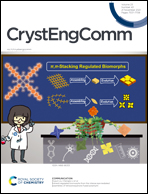A water-stable photochromic MOF with controllable iodine sorption and efficient removal of dichromate†
Abstract
The incorporation of photochromic units into metal–organic frameworks (MOFs) is of particular interest due to their ability to endow the MOFs with extra functions such as photomodulated fluorescence, photomagnetism, and photomodulated electrical conductivity. In this work, a π-conjugated electron-deficient viologen ligand was assembled with La3+, resulting in a stable cationic MOF with one-dimensional channels, namely [La(bdpbpy)(H2O)2]·NO3·5H2O (1-NO3) (H4bdpbpy·2Cl = 1,1′-bis(3,5-dicarboxyphenyl)-4,4′-bipyridinium dichloride). As expected, 1-NO3 exhibits photochromism accompanied by an obvious color change from yellow to brown under UV-vis light irradiation. Remarkably, the water stable cationic framework of 1-NO3 acts as an efficient and selective trap for toxic dichromate through ion-exchange. The π-conjugated electron-deficient viologen ligand in the framework can provide extra affinity for iodine adsorption, and thus 1-NO3 exhibits sorption behaviours for iodine molecules. More importantly, the iodine adsorption capacity of 1-NO3 was significantly reduced when it was irradiated by UV-vis light. This is attributed to the photoinduced electron transfer (PET) changing the original charge distribution of the bipyridinium moieties on the channel and weakening the affinity for the N+⋯I–I interaction. This work breaks through the traditional design strategy to construct MOF adsorbent materials with controllable adsorption capacity.

- This article is part of the themed collection: Coordination Networks


 Please wait while we load your content...
Please wait while we load your content...